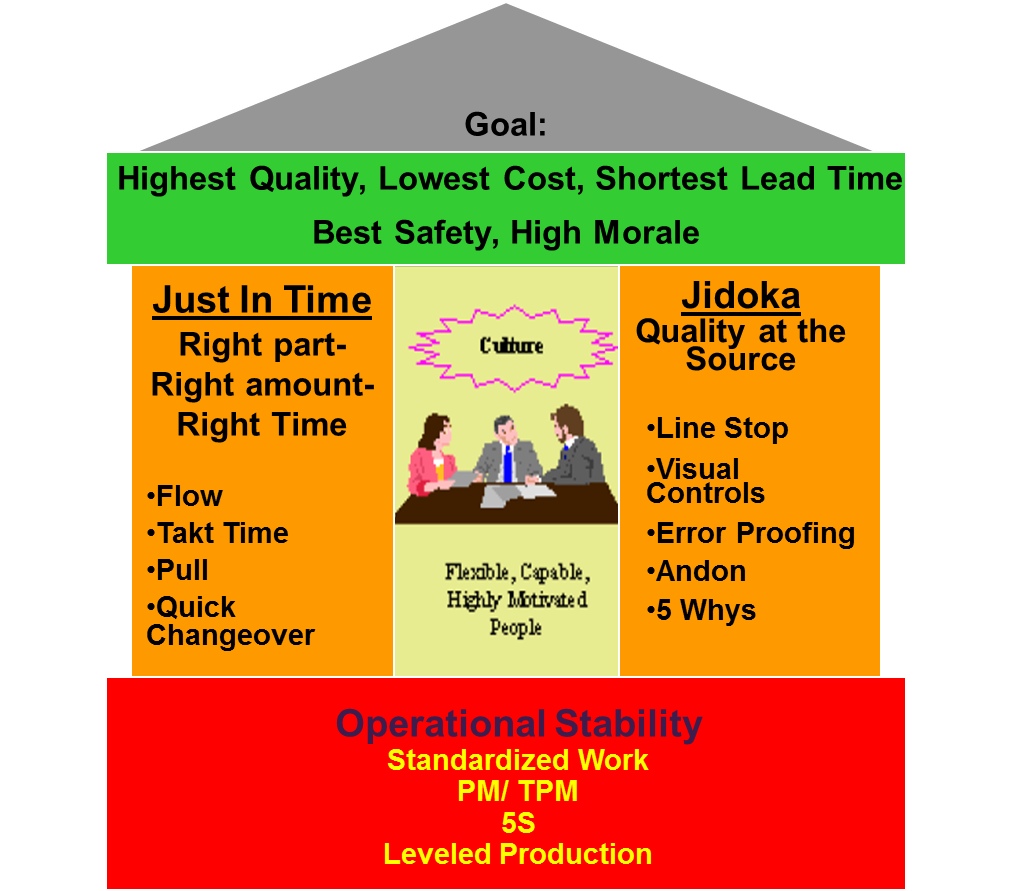What is Lean Manufacturing?
Lean manufacturing is the term most commonly used to describe the Toyota Production System (TPS). In the above figure, we have the TPS house. At the base, we have operational stability, which means creating consistency in methods and tasks, equipment, workplace organization, and output of work. There are two pillars that we speak of as well. Just-In-Time means providing the next downstream customer with what they need when they need it and in the right quantity. Built in Quality or Quality at the Source, the second pillar, essentially means never knowingly passing defective product or information to the next downstream customer. These concepts, combined with respect for people and a culture of continuous improvement, lead to the best quality, lowest cost, and shortest-lead-time products and services.
Lean manufacturing includes a set of principles that lean thinkers use to achieve improvements in productivity, quality, and lead-time by eliminating waste through kaizen. Kaizen is a Japanese word that essentially means "change for the better" or "good change." The goal is to provide the customer with a defect free product or service when it is needed and in the quantity it is needed.

The Five Principles of Lean
The 5 principles of lean thinking that lean manufacturers employ are, according Jim Womack and Daniel Jones in Lean Thinking:
Specify Value.
Identify the Value Stream.
Make Value Flow.
Let the customer Pull.
Seek Perfection (Continuous Improvement of Quality and Productivity).
The Seven Wastes
Taichi Ohno, former Toyota Chief Engineer, identified 7 wastes of manufacturing:
Overproduction
Transportation
Inventory or Storage
Inappropriate Processing
Waiting
Motion
Defects or Correction
These wastes should not be considered separate categories; instead, we should use these wastes as a teaching/learning tool to help identify opportunities to improve our work environment and focus on adding value for the customer. Wastes are non-value-added activities for which the customer would not be willing to pay.
Lean Concepts and Tools
There are many tools and concepts that lean companies employ to support the above principles and eliminate such wastes including:
Takt Time - The heartbeat of the customer; the average rate at which a company must produce product or execute transactions based on customer requirements and available working time.
Standardized Work - A description of methods, materials, tools, and processing times required to meet takt time for any given job.
One Piece Flow or Continuous Flow - A methodology by which product or information is produced by moving at a consistent pace from one value-added processing step to the next with no delays in between.
Pull Systems and Kanban- A methology by which a customer process signals a supplying process to produce product or information or deliver product/information when it is needed. Kanban are signals used within a pull system.
Five Why's - A thought process by which the question "why" is asked repeatedly to get to the root cause of a problem.
Quick Changeover / SMED - A 3-stage methodology developed by Shigeo Shingo that reduces the time to changeover a machine by externalizing and streamlining steps. Shorter changeover times are used to reduce batch sizes and produce just-in-time.
Mistake Proofing / Poka Yoke- A methodology that prevents an operator from making an error.
Heijunka / Leveling the Workload - The idea that, although customer order patterns may be quite variable, all of our processes should build consistent quantities of work over time (day to day, hour to hour).
Total Productive Maintenance (TPM) - A team-based system for improving Overall Equipment Effectiveness (OEE), which includes availability, performance, and quality.
Five S - 5S is a five step methodology aimed at creating and maintaining an organized visual workplace.
A-3 Problem Solving / PDCA / PDSA - A system for identifying and solving problems to their root cause and then implementing countermeasures with monitoring. Typically these are reported using A-3 reports (on A-3 or 11 X 17 size paper).

